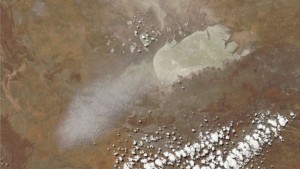“With huge plumes of particles rising into the atmosphere from deserts and farmland, the question is whether they raise temperatures or lower them.” This quote is from a new BBC article on studying the impacts of dust on local and global climate.
We’ve all seen pictures of huge dust storms, both in the “Dust Bowl” Era and more recently coming off of dry lake beds and deserts. Climatologists know that the role of dust in controlling the climate depends a lot of where the dust is. More dust in the air could reduce the amount of sunlight that is able to get to the earth’s surface, cooling it. Or the dust could act as a blanket, trapping heat near the ground and warming it. Dust coming off the Sahara at high elevations can reduce the number of hurricanes formed in the Atlantic Ocean. Dust at the surface blowing into the ocean can provide nutrition for plankton, who then suck up carbon dioxide through increased photosynthesis. Very little is known about how each of these impacts affects climate, much less how they all interact together.
We do know that dust can become a health hazard in the areas downwind of the source area through extra particulate pollution and pathogens which are blown by the wind. Dust is also something that is likely to increase over time due to increased desertification and warmer temperatures which are expected to dry out soils.
You can read the BBC article at https://www.bbc.com/news/science-environment-35024610.
